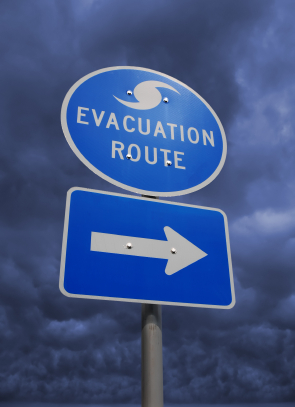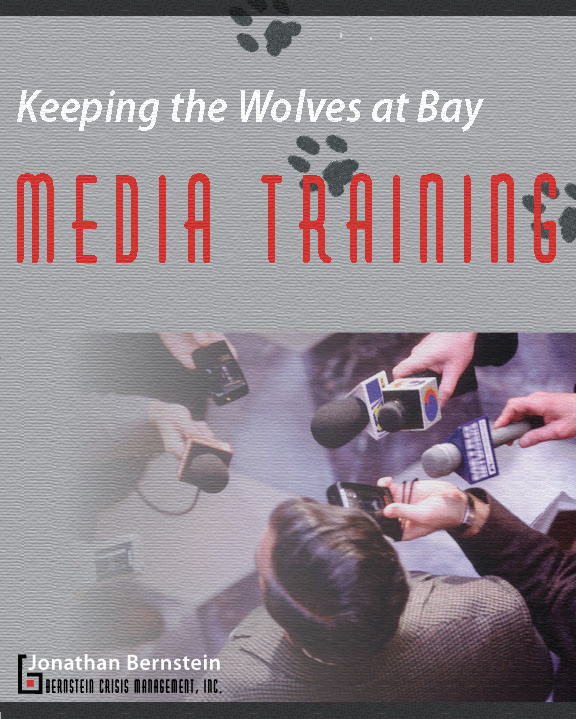|
|

|
CRISIS MANAGER
The Internet Newsletter about Crisis Management
Editor: Jonathan Bernstein
"For Those Who Are Crisis Managers,
Whether They Want to be or Not"
ISSN:1528-3836
� 2010 Jonathan Bernstein
|
Volume XI, Number 13
| September 2, 2010
|
|
JUST A THOUGHT
Your brand is what your customers think it is, not what you think it is. So listen, engage, and if the message you want is not the message they're repeating, alter your strategy.
| Cindy Ratzlaff
|
|
FROM THE EDITOR
This issue features articles by two authors I greatly admire -- one new to me, one a long-time acquaintance.
I just discovered online branding and marketing expert Cindy Ratzlaff, even though apparently I'm the next to last person on the Internet to do so. She had this marvelous short piece on her blog about how to defuse the fear many have of social media, a fear I have long preached must be overcome by anyone communicating in the 21st Century.
Then, with Hurricane Earl churning up the East Coast of the United States as I write this, I was grateful to get permission to run a long piece by disaster preparedness pro Don Schmidt. I urge you to read it closely whether you are in hurricane territory or not -- because much of the advice therein also applies to prepping for tornadoes, earthquakes, and other disasters. You'll also benefit from signing up for Don's ezine, which talks a lot more about this broad topic.
As always, if you like what you see, please share it with others by using the "Forward Email" link at the bottom of the ezine and tell them to subscribe! IMPORTANT NOTE: If you just "Forward" using your own email program's "Forward" function and your recipient thinks they're being spammed, they can click on the Opt Out link and opt YOU off the list. So use the "Forward Email" link, please.

My best to all, Jonathan
|
FEAR NO SOCIAL MEDIA
By Cindy Ratzlaff
| One of the biggest concerns companies have about venturing onto social media is a fear that detractors, competitors or others who dislike their brand will comment publicly, venting their problem and leaving open the door for a lot of negative viral buzz. Their thinking is that if they aren't on Facebook, Twitter, YouTube or any of the other major sites, those naysayers or disgruntled types will have no public venue through which to flog them. The fatal flaw in this strategy is that angry consumers or clients don't need a home base through which to damage a company and its reputation. They have their own home base through their individual social media platforms. When a plane is stuck on the runway for more than three hours, hundreds of passengers will take to Twitter with the hashtag #Airlinenamefail or something similar and soon enough thousands will be aware of their plight.
Your brand is what your customers think it is, not what you think it is. So listen, engage, and if the message you want is not the message they're repeating, alter your strategy.
If a company stays away from social media so as to avoid negative online feedback they will accomplish two things:
They will be unaware of problems that might have been easily resolved but when left alone may become much bigger problems.
They will be miss a valuable opportunity to fix minor problems and turn cranky customers into happy evangelizers.
Mashable wrote an excellent post recently sharing three terrific examples of how major brands monitored, managed and resolved (or not) some important brand missteps and criticism.
Bottom line: The conversation about you is going on with or without you. You can only influence it if you are aware of it. Every company should be active on Facebook and Twitter, at the very least, to monitor and influence their brand reputation. Every company should have a Google alert set for their key words and get that digest daily. Every company should search their brand name or the name of their current campaign on Twitter daily.
Cindy Ratzlaff, has been named one of the Top 30 Women Entrepreneurs to Follow on Twitter by Forbes and one of the top 20 Best Branded Women by Forbes Woman and has been named to the Ad Age Marketing 50 List.
|
HURRICANE RESPONSE
By Donald L. Schmidt
Hazard Mitigation
Hazard
mitigation can substantially reduce the damage caused by hurricanes. Property
insurer FM Global compared the loss history of its policyholders that
implemented its loss prevention recommendations with those with outstanding
recommendations to complete. FM found that those policyholders that fully
implemented its preparedness recommendations had on average 75% to 85% lower
dollar losses than those policyholders that did not implement such measures [FM
Global data provided to InterCEPi]. prevention recommendations with those with outstanding
recommendations to complete. FM found that those policyholders that fully
implemented its preparedness recommendations had on average 75% to 85% lower
dollar losses than those policyholders that did not implement such measures [FM
Global data provided to InterCEPi].
Prior
to hurricane season survey the entire property and inspect all buildings to
identify vulnerabilities. Begin at the roof level and inspect the flashing
along the perimeter. Repair loose or damaged flashing and ensure sufficient
mechanical fasteners are used.
Inspect
the roof covering for evidence of ponding, blistering, alligatoring,
delamination, surface erosion, or cracks that could result in tears or leaks.
Verify that all access panels and doors to mechanical equipment and roof
hatches have been property secured. Confirm that all antennas, satellite
dishes, and other appliances installed on the roof have been secured to
withstand hurricane wind forces.
Inspect
all exterior walls for openings that could be penetrated by wind and evaluate
methods to protect when a storm watch is issued. Consider installing glazing
rated to withstand debris impact or hurricane shutters on exterior glass that
is especially vulnerable. Check all exterior doors especially loose fitting,
large overhead doors. Make exterior doors weather tight and equip them with
secure latches.
Inspect
exterior storage, tanks, equipment, signs, and vehicle storage and verify they
are properly anchored to withstand expected wind forces. Identify what can be
moved inside a building or removed from the site, if a storm watch is issued.
Focus
on critical building areas, equipment, and utilities including data centers and
process systems. Evaluate means to protect against damage from water entry in
the event of structural damage or flooding.
Resources
There
are many resources needed for hurricane preparedness. First, identify the
complement of staff, including contract employees, needed to prepare your
facility in the available time between a hurricane watch and hurricane warning.
Procure
materials and equipment to prepare the facility including storm shutters,
plywood, sandbags, and the power tools, equipment, and supplies to install
them. A supply of tarpaulins and plastic sheeting can be used to cover valuable
furnishings or equipment and provide temporary protection after a storm.
Service pumps and emergency generators to ensure they are in good condition,
and calculate the required quantity of fuel for each.
Procure
weather monitoring equipment and ensure reliable access to broadcast and
internet weather reports including forecasts from the National Hurricane
Center. On-site weather monitoring equipment enable you to monitor local wind
conditions and rainfall.
Evaluate
communications capabilities assuming that landline telecommunications may be
interrupted. Test communications equipment including two-way radios and
satellite telephones. Evaluate how communications equipment could be used if
roof mounted antennas are damaged.
Stockpile
supplies for cleanup and repairs. Don't forget food and water for employees
restoring the facility.
Arrange
in advance for procurement of equipment, supplies, and contractors from firms
located well outside the immediate area for cleanup, repair, and restoration of
buildings, equipment and stock. Establish mutual aid agreements with other
company facilities outside the storm's potential impact area.
Hurricane
Preparedness
Write
a hurricane preparedness plan that includes multiple phases:
- Before
hurricane season
- Tropical
Storm or Hurricane Watch
- Tropical
Storm or Hurricane Warning
- During
the Storm (only if personnel must and are authorized to remain on-site during a
storm)
- After
the Storm
Watch
and warning phases can be expanded to include additional actions when a major
hurricane has been forecast and to address a facility's vulnerabilities to
hurricane hazards.
Before Hurricane
Season
Preparedness
prior to hurricane season begins with conducting or reviewing the facility's
hurricane risk assessment, which is the basis for the hurricane plan.
- Contact
public officials to obtain the latest information on wind fields, storm surge,
and flooding, which should be incorporated into your plan. If available, obtain
official credentials for managers that will enable them to re-enter your
facility after a storm but before the area is opened to the general public.
- Walk
the entire site and facility top to bottom to evaluate vulnerabilities and hazard
mitigation. Complete hazard mitigation activities as soon as possible.
- Review
property insurance coverage including flood coverage, which may require a
special endorsement. Evaluate business interruption limits especially if
multiple facilities may be impacted by a single storm.
- Verify
that all resources required for preparing the facility for a hurricane are
available and in good condition. This includes all pumps, generators,
communications equipment, personal protective equipment, hand and power tools,
and supplies.
- Conduct
training of all staff, so they know their role and responsibilities as defined
in the plan. Conduct a tabletop exercise to familiarize the leaders of your
hurricane preparedness and response team with the plan and identify any gaps or
deficiencies.
Storm
or Hurricane Watch
When
a hurricane watch is issued, hurricane conditions are possible within 36 hours.
- Physically
check all emergency and communications equipment including generators, transfer
switches, lighting, portable pumps, and radios. Test all and ensure that
generators will start automatically and power transfers properly. Check oil
levels and fuel tanks and fill to capacity.
- Fill
all propane gas, fuel oil or other storage tanks (both aboveground and buried)
to prevent them from floating.
- Identify
any hazardous materials that could react with water and relocate outside the
path of the storm or protect from contact with water.
- Fill
available portable fuel tanks (for portable power equipment) and store in a
location protected from wind and flood.
- Inspect
roof edging strips, gutters, flashing, covering, and drains. Remove anything
from the roof that is not secured.
- Inspect
rooftop air handling units to ensure that latches are securely fastened.
- Inspect
exterior signs supports, guy wires, and anchorages; secure as necessary.
- Check
for weak door and window latches and hardware or for insecure panel fastenings.
- Check
roof, floor and yard drains to ensure they are clear and unobstructed.
- Clean
out street catch basins and drains to prevent street flooding.
- Cover
exterior building make-up air or ventilation louvers by securely fastening a
sheet of plywood to the inside of the opening. Remove after the storm has
passed in order to provide adequate ventilation.
- Fasten
sheets of heavy plywood over exterior windows and doors to prevent breakage
that will exacerbate wind damage to the roof system as well as allow water to
enter the building. Taping windows can be done to minimize the flying glass
hazard, if windows can't be covered with plywood.
- Check
grounds and remove dead limbs, prop weakly rooted trees, clean up loose debris,
and move all articles or equipment that can be picked up by high winds
inside-if it isn't bolted down, move it inside.
- Empty
trash compactor and/or dumpster; make sure any compactor is secured properly.
- Cover
valuable electronic equipment, artwork, furniture, etc.
Hurricane
Warning
When
a hurricane warning is issued, sustained winds greater than 74 mph or higher
associated with a hurricane are expected in a specified coastal area in 24
hours or less. Preparations must be rushed to completion before any mandated
evacuation order is issued.
After
the Storm
A
damage assessment protocol should be developed and assignments made to quickly
assess the condition of infrastructure, buildings, utilities, furniture,
equipment, and supplies. Prior to conducting the damage assessment, identify
hazards such as downed electrical lines, leaking hazardous materials (e.g.,
liquids and gases), broken glass, and collapse hazards. Prohibit entry into
unsafe areas.
- Cover
up openings in the building shell with plastic sheeting or tarpaulins, begin
salvage operations, and cleanup debris and remove standing water as soon as it
is safe to do so.
- Inspect
electrical and process systems and equipment for water damage before
restarting.
- If
electrical or electronic equipment is exposed to water, keep it turned off
until it has been dried, cleaned and checked by a trained individual.
- Drain,
clean and lubricate any machinery before testing. Contact the manufacturer, if
possible, for recommendations.
- Do
not operate boilers until they have been inspected and tested.
- Compile
a report with the results of the damage assessment to begin the insurance
claims process.
Family
Preparedness
In
addition to planning for your facility, be sure to provide preparedness
information for employees to share with their families. Distribute information
from Ready.gov and your local emergency management agency.
Ask
all employees to develop a family disaster plan that includes a communications
plan. Encourage them to prepare a family disaster kit. Make sure that you have
emergency contact information for all employees, which includes the name and
telephone numbers for a distant relative who can be contacted if the employee
has evacuated.
Coordination
with emergency management officials is essential to ensure you have the latest
forecast, are aware of the timing for issuance of mandatory evacuation orders,
and understand the time needed to safely evacuate on crowded roads.
The
availability of resources to prepare a facility becomes limited when a
hurricane watch is issued as businesses and citizens compete for materials and
labor. Employees have to prepare their own homes and ensure the safety of
family members.
A
hurricane plan that accurately identifies the resources and time needed to
prepare a facility has the greatest chance of success. Procuring necessary
resources before hurricane season and arranging in advance for labor to assist
with hurricane preparations is essential. Providing resources to protect the
homes of managers will allow them to focus their attention on preparing your
facility.
Build
a project management plan that defines major tasks and the resources and time
needed for completion. Use the timeline to calculate when preparations must
begin, so they are completed before a mandatory evacuation order is issued.
Donald L. Schmidt,
CEO of Preparedness LLC, Donald L. Schmidt
 |
www.preparednessllc.com, has 30 years of experience in
the public sector and the private sector. He has extensive experience in risk
assessment, hazard prevention, risk mitigation, emergency management and
business continuity plan development, training, and exercising within a diverse
range of industries.
|
|
BUSINESS ANNOUNCEMENTS
(aka blatant self-promotion)
Keeping the Wolves at Bay: Media Training
What has 80+ pages of hard-hitting, entertaining and easy-to-read guidance on how to deal with both traditional and online media during times of crisis? The answer is
Keeping the Wolves at Bay - Media Training. The, four-color, perfect-bound, 8x10 manual is currently available both in hardcopy ($25) and PDF form ($10). Volume discounts are available; write to Jonathan Bernstein for that information.
Here's a couple of teaser reviews for you:
Jonathan Bernstein's Keeping the Wolves at Bay is an eminently practical guidance for anyone - business leader, celebrity, politician - who must willingly or unwillingly face the glare of media attention. It appears
at a moment in time when the social media and other digital communications have upped the ante exponentially.
Bernstein's practicum on media relations takes on renewed urgency as news, gossip, and opinion now drive
public perception virally and at the speed of light.
Richard Levick, Esq.
President & CEO
Levick Strategic Communications, LLC
Even if you think
you'll never, ever be interviewed by the media, buy this book and read it cover
to cover. It isn't a substitute for media training. But it will give you the
tools and confidence to go head to head -- and possibly even defang -- rabid reporters,
blood-thirsty bloggers and social networking buffoons who are out to besmirch
your good name. Joan Stewart, The Publicity Hound
The book and other products can be found at the
Crisis Manager Bookstore
Want To Blog
And Tweet About
Your Organization But Don't Have Time?
Missing out on all the promotional and SEO
advantages of doing so? Hire someone to be your voice...like Erik Bernstein,
aka "Son of Crisis Manager."
More info:[email protected].
|
GUEST AUTHORS
GUEST AUTHORS are very welcome
to submit material for "Crisis Manager." There is no fee paid, but most
guest authors have reported receiving business inquiries as a result of
appearing in this publication. Case histories, experience-based
lessons, commentary on current news events and editorial opinion are
all eligible for consideration. Submission is not a guarantee of
acceptance.
|
ABOUT THE EDITOR & PUBLISHER
Jonat han Bernstein is president of Bernstein Crisis Management, Inc., a national crisis management public relations agency providing 24/7
access to crisis response professionals. The agency engages in the full
spectrum of crisis management services: crisis prevention, response,
planning & training. He has been in the public relations field
since 1982, following five-year stints in both military intelligence
and investigative reporting. Write to [email protected]. han Bernstein is president of Bernstein Crisis Management, Inc., a national crisis management public relations agency providing 24/7
access to crisis response professionals. The agency engages in the full
spectrum of crisis management services: crisis prevention, response,
planning & training. He has been in the public relations field
since 1982, following five-year stints in both military intelligence
and investigative reporting. Write to [email protected].
|
|
LEGAL
DISCLAIMER
All
information contained herein is obtained by Jonathan Bernstein from sources
believed by Jonathan Bernstein to be accurate and reliable.
Because of
the possibility of human and mechanical error as well as other factors, neither
Jonathan Bernstein nor Bernstein Crisis Management is responsible for any
errors or omissions. All information is provided "as is" without
warranty of any kind. Bernstein Crisis Management and Jonathan Bernstein make
no representations and disclaim all express, implied, and statutory warranties
of any kind to the user and/or any third party including, without limitation,
warranties as to accuracy, timeliness, completeness, merchantability, or
fitness for any particular purpose.
Unless due
to willful tortuous misconduct or gross negligence, Jonathan Bernstein and
Bernstein Crisis Management shall have no liability in tort, contract, or
otherwise (and as permitted by law, product liability), to the user and/or any
third party.
Under no
circumstance shall Bernstein Crisis Management or Jonathan Bernstein be liable
to the user and/or any third party for any lost profits or lost opportunity,
indirect, special, consequential, incidental, or punitive damages whatsoever,
even if Bernstein Crisis Management or Jonathan Bernstein has been advised of
the possibility of such damages.
A service
of this newsletter is to provide news summaries and/or snippets to readers. In
such instances articles and/or snippets will be reprinted as they are received
from the originating party or as they are displayed on the originating website
or in the original article. As we do not write the news, we merely point
readers to it, under no circumstance shall Bernstein Crisis Management or
Jonathan Bernstein be liable to the user and/or any third party for any lost
profits or lost opportunity, indirect, special, consequential, incidental, or
punitive damages whatsoever due to the distribution of said news articles or
snippets that lead readers to a full article on a news service's website, even
if Bernstein Crisis Management or Jonathan Bernstein has been advised of the
possibility of such damages. Authors of the original news story and their
publications shall be exclusively held liable. Any corrections to news stories
are not mandatory and shall be printed at the discretion of the list moderator
after evaluation on a case-by-case basis.
|
|
|
|
|
|
|
|